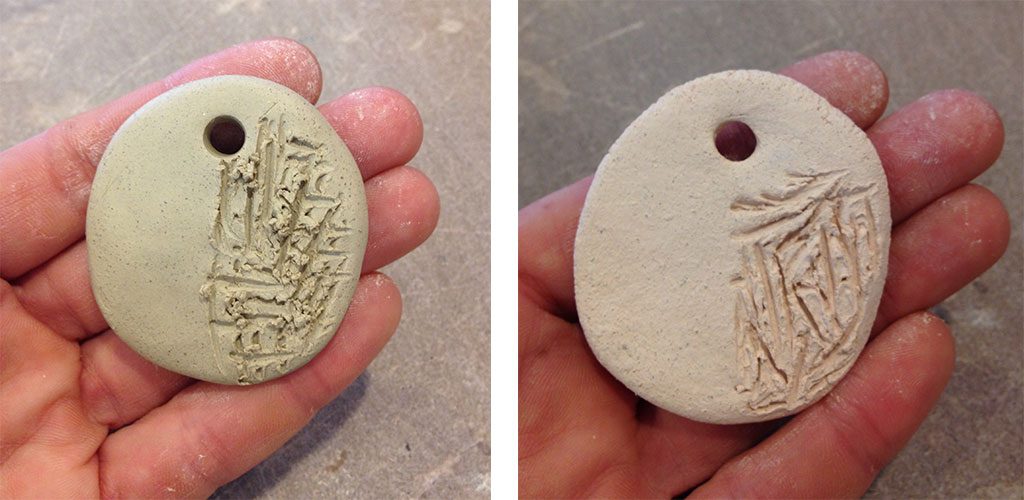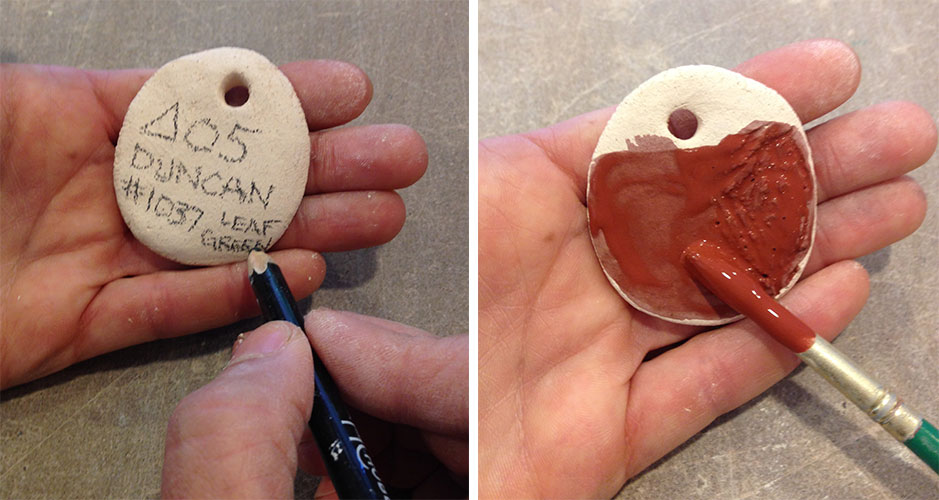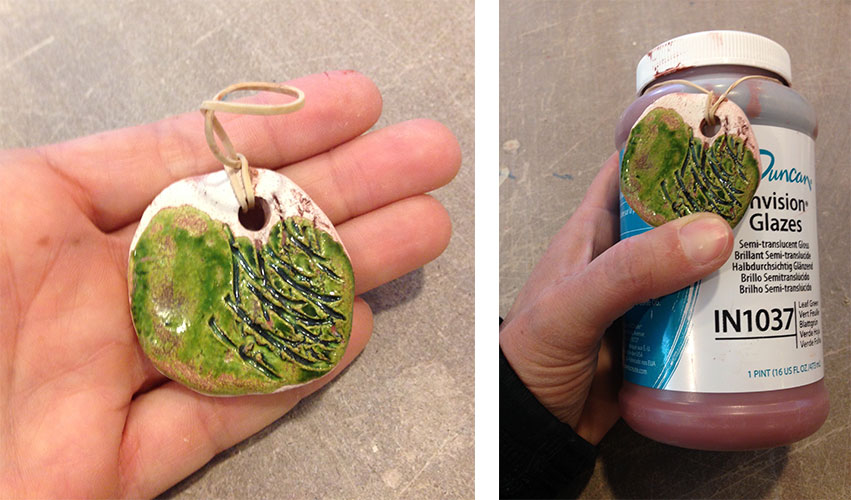Every ceramic program has their own way of making test tiles of their glazes to share with their students. Some are very elaborate systems that give you all the information you could ever need to know about a glaze but with my students in a classroom setting, just knowing what color it will be seems to be enough information. I will never forget the look on a students face when I handed him his green penguin. He just didn’t believe me that the seeming black goop in the jar would magically turn green in the kiln- surprised to say the least!
 I like to make tags that can be attached to the jar so that as they move around the classroom, the correct tag stays with the correct jar. I use the same clay we are building with and make small pancake shapes that are about 1 1/2″ across. I texture half of the tag and put a hole in the top to eventually hang it by. If you know what glazes you are using, you might want to write the name with a sharp tool onto the back of the tag while the clay is wet. If you want to make a bunch and label them later, you can do that too. Then bisque fire them.
I like to make tags that can be attached to the jar so that as they move around the classroom, the correct tag stays with the correct jar. I use the same clay we are building with and make small pancake shapes that are about 1 1/2″ across. I texture half of the tag and put a hole in the top to eventually hang it by. If you know what glazes you are using, you might want to write the name with a sharp tool onto the back of the tag while the clay is wet. If you want to make a bunch and label them later, you can do that too. Then bisque fire them.
 I label mine with an underglaze pencil made by Amaco, they write just like a pencil but are fired onto the clay permanently. I include the temperature, the brand name and the color by name and number. Then paint on your glaze to the front of the test tag. I like to do an area with one coat, two coats and three coats so you can see how the glaze changes in translucency or richness of color. Some glazes will look very different when they pool in the textured area of the test tile too. Once they are painted, glaze fire them to the appropriate temperature for the glaze you are testing.
I label mine with an underglaze pencil made by Amaco, they write just like a pencil but are fired onto the clay permanently. I include the temperature, the brand name and the color by name and number. Then paint on your glaze to the front of the test tag. I like to do an area with one coat, two coats and three coats so you can see how the glaze changes in translucency or richness of color. Some glazes will look very different when they pool in the textured area of the test tile too. Once they are painted, glaze fire them to the appropriate temperature for the glaze you are testing.
 When you have your tiles done, loop and elastic band through the hole at the top and then around the neck of the glaze bottle. When you run out of glaze, you can easily take off the label and place it on the new bottle. My new students always have a hard time believing that this rusty red glaze will turn to leaf green with just a little help from the kiln. Happy Glazing!
When you have your tiles done, loop and elastic band through the hole at the top and then around the neck of the glaze bottle. When you run out of glaze, you can easily take off the label and place it on the new bottle. My new students always have a hard time believing that this rusty red glaze will turn to leaf green with just a little help from the kiln. Happy Glazing!
Clay in the Classroom: Glaze Tags
2 thoughts on “Clay in the Classroom: Glaze Tags”
Comments are closed.
Hi! Yes, that is very helpful because of the color that changes when its baked. Were can I get those kind of paints. I am an artisan and I work with baked mud clay. If you have a website that I can purchase this kind of paints. Please send me the info, I’ll appreciated.
Hi Alexandra, Look to see if you have a ceramic supply store in your area and they will be able to help you find the right glazes for the clay you are working with. You can order ceramic glazes online from a number of websites but you need to know what temperature you are firing your clay to and match the glazes to that temperature. Hope that helps!